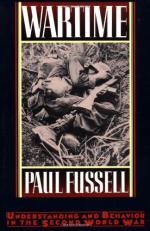
|
| Name: _________________________ | Period: ___________________ |
This test consists of 15 multiple choice questions and 5 short answer questions.
Multiple Choice Questions
1. Which of the following is NOT one of the things that American soldiers were told they were fighting for?
(a) Democracy.
(b) Enfranchisement.
(c) Freedom.
(d) Safety.
2. Media outlets were concerned with the esprit de corps in what areas?
(a) At the front and at home.
(b) In headquarters.
(c) In Europe only.
(d) Abroad.
3. What was a soldier's primary source of information?
(a) Stateside media.
(b) Hand bills and flyers.
(c) Official military publications.
(d) Word of mouth.
4. Overall, the media coverage of the war would best be described as which of the following?
(a) Deceitful.
(b) Homogeneous.
(c) Random.
(d) Inadequate.
5. Which of the following best describes what the author believes about the US media's depiction of warfare?
(a) It was generally accurate.
(b) It was falsified.
(c) It was misleading.
(d) It was inadequate.
6. Idioms were often adapted to what medium?
(a) Song.
(b) Advertising jingles.
(c) Poetry.
(d) Journalism.
7. Most of the efforts discussed in America and Britain were aimed at which of the following?
(a) Getting citizens to manufacture products in their space time.
(b) Increasing the resiliency of industry.
(c) Creating new products.
(d) Reducing use of products.
8. What is one major product for which many improvised substitutes were devised?
(a) Bread.
(b) Butter.
(c) Gasoline.
(d) Coffee.
9. What was the state of the global economy before the war began?
(a) Steady growth.
(b) Boom.
(c) Recession.
(d) Depression.
10. How was God related to the war in the political and media interpretation in America?
(a) God was on the allies' side.
(b) God wanted the German people to be punished.
(c) God wanted to war to end.
(d) God had allowed the war to happen.
11. What practice became popular at home during the war?
(a) Marches.
(b) Parades.
(c) Home defense drills.
(d) Group-singing.
12. Overall, the media presented the war effort as being which of the following?
(a) An immoral act of aggression.
(b) A struggle to the death.
(c) A good-versus-evil apocalypse.
(d) An unwinnable debacle.
13. When were most enduring war novels written?
(a) Before America's entry into the war.
(b) During the later days of the war.
(c) During the early days of the war.
(d) After the war.
14. The author states that it was common for the media to suggest that individual soldiers died for what reason?
(a) To defeat Socialism.
(b) Because of minor mistakes and chance events.
(c) Due to his own failings.
(d) The defense of liberty.
15. What type of story is specifically cite as being very likely to be reported by mainstream media of the era?
(a) Biographies of individual soldiers.
(b) Great victories.
(c) Detailed accounts of campaigns.
(d) Reports from allied bombing raids.
Short Answer Questions
1. Overall, the author believes that the political and media-based interpretation of the war was what?
2. What was done in England to frustrate a potential invading force?
3. What type of novels became more popular during the war?
4. Most soldiers believed that the meaning and purpose of the war was which of the following?
5. How did the media handle the worst aspects of the war?
|
This section contains 513 words (approx. 2 pages at 300 words per page) |

|




